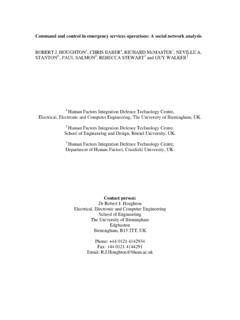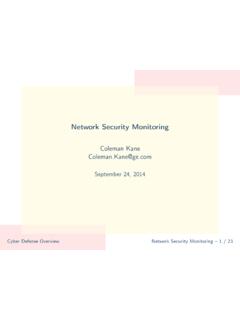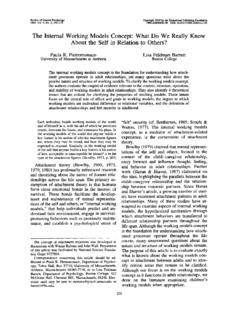Transcription of What is Direct Memory Access (DMA) and Why Should We …
1 Introduction to Operating SystemsWhat is Direct Memory Access (DMA)andWhy Should We know About it?John FrancoElectrical Engineering and Computing SystemsUniversity of Cincinnati IntroductionWhat is Direct Memory Access ? Hardware mechanism that allows peripheral components to transfer their I/O data directly to and from main Memory without the need to involve the system is Direct Memory Access important? Use of this mechanism can greatly increase throughput to and from a device, because a great deal of computational overhead is eliminatedWhat is the downside?
2 Hardware support is required DMA controllers DMA steals cycles from the processor Synchronization mechanisms must be provided to avoid accessing non-updated information from RAM IntroductionWhat is Direct Memory Access ? DMA is a capability provided by some computer bus architectures, including PCI, PCMCIA and CardBus, which allows data to be sent directly from an attached device to the Memory on the host, freeing the CPU from involvement with the data transfer and thus improving the host's Programming The programming of a device's DMA controller is hardware specific.
3 Normally, the OS needs to have the local device address, the physical Memory address on the PC, and the size of the Memory block to transfer. Then the register that initiates the transfer is set. Introduction Elaboration DMA transfers overcome the problem of occupying the CPU for the entire time it's performing a transfer. The CPU initiates the transfer, then it executes other ops while the transfer is in progress, finally it receives an interrupt from the DMA controller when the transfer is done Hardware using DMA: disk drives, graphics cards, network cards, sound cards DMA can lead to cache coherency problems If a CPU has a cache and external Memory , then the data the DMA controller has Access to (stored in RAM) may not be updated with the correct data stored in the cache.
4 Introduction Cache Coherency Solutions Cache-coherent systems: external writes are signaled to the cache controller which performs a cache invalidation for incoming DMA transfers or cache flush for outgoing DMA transfers (done by hardware) Non-coherent systems: OS ensures that the cache lines are flushed before an outgoing DMA transfer is started and invalidated before a Memory range affected by an incoming DMA transfer is accessed. The OS makes sure that the Memory range is not accessed by any running threads in the meantime.
5 Introduction Overview (input example) software: asks for data ( read called) 1. Device driver allocates a DMA buffer, sends signal to device indicating where to send the data, sleeps 2. Device writes data to DMA buffer, raises interrupt when finished 3. Interrupt handler gets data from DMA buffer, acknowledges interrupt, awakens software to process the data DMA Transfer Overview (input example) hardware: asynchronously pushes data to the system May push data even if no process is listening! 1. hardware raises an interrupt to announce that new data has arrived 2.
6 Interrupt handler allocates a buffer, tells the hardware where to transfer the data 3. device writes the data to the buffer, raises another interrupt when transfer is done 4. interrupt handler dispatches the new data, awakens any relevant process, and takes care of housekeeping DMA Transfer Overview (input example network transfers) hardware: must deal with continuous data flow Use a circular (ring) buffer in Memory shared by device and the processor 1. incoming packet placed in next available buffer In the ring 2.
7 Interrupt is raised by the device 3. device driver sends packet to kernel code that will process it 4. device driver inserts a new buffer into the ring (note: buffer allocation occurs at initialization so the insertion of a buffer is just the selection of an already allocated buffer for the ring) DMA Transfer Overview (input example network transfers) pseudo code for read using circular buffer Err_Type Procedure read(data_type data) { if (empty_flag) return (ERR_BUF_EMPTY); else { Memory (read_ptr) = data; full_flag = false; read_ptr = (((read_ptr B)+1)mod N)+B; if (read_ptr == write_ptr) empty_flag = true.}}
8 Return(Err OK); } } DMA Transfer Graphically: DMA Transfer Allocation Buffers: contiguous buffer: contiguous block of Memory allocated scatter/gather: allocated buffer can be fragmented in the physical Memory and does not need to be allocated contiguously. The allocated physical Memory blocks are mapped to a contiguous buffer in the calling process's virtual address space, thus enabling easy Access to the allocated physical Memory blocks. bounce buffer: to allow devices with limited addressing to Access all of virtual address space.
9 A bounce buffer resides in Memory low enough for a device to copy from and write data to. It is then copied to the desired user page in high Memory Allocating a DMA Buffer Considerations PCI: Must occupy contiguous pages in physical Memory due to PCI bus requirement using physical addresses Note: other buses ( Sbus) use virtual Memory addresses for the transfer The right kind of Memory must be allocated since not all Memory zones are suitable: high Memory may not work with some devices because of limited address space Memory can be allocated at boot or runtime but drivers can only allocate at runtime Allocating a DMA Buffer How to Allocate (low level): Use mem=xxx to reserve Memory beginning at xxx - done at boot Then use dmabuf = ioremap(0xFF00000, 0x100000); to create the buffer in the driver Allocate from the DMA zone (16 MB) struct page *buf; buf = alloc_pages(__GFP_DMA, 3).
10 Where 3 is the order and means (1 << 3) pages (from the buddy system allocator) Use scatter/gather I/O if the device supports it Allocating a DMA Buffer How to Allocate (generic DMA layer): DMA based hardware uses bus addresses - these do not match with PCI physical addresses Can convert at low-level but then risk inconsistency across systems Also, different systems have different expectations of cache coherency hence allocate at generic layer Device may have DMA limitations 32 bit addressing is assumed but may be changed with int dma_set_mask(struct device *dev, u64 mask).












